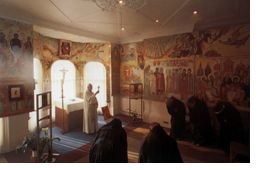 The nun Joanna (who always called herself 'Sister') - in the world, Julia Nikolayevna Reitlinger, - was born in Petersburg in 1898 and died in Tashkent in 1988. She had lived a long life. The fate of the 'first wave' of emigrants, whose cultural and religious achievement is still not fully known to us or understood by us, was reflected in that life, as in a mirror. J.N. Reitlinger was an outstanding master of 20th century icon painting. But whereas the names of other great icon painters of the Russian diaspora, such as her pupil Father Gregory Krug, or Leonid Uspensky, are well known and as respected in the West as they are in Russia, the work of Sister Joanna is known to only a few. Nevertheless, she worked a great deal and fruitfully in France and in England and in Czechoslovakia, especially in the 1930's and 40's. She continued to work when she returned to her native land (if you can call Tashkent her native land), up to the 1970's. The nun Joanna (who always called herself 'Sister') - in the world, Julia Nikolayevna Reitlinger, - was born in Petersburg in 1898 and died in Tashkent in 1988. She had lived a long life. The fate of the 'first wave' of emigrants, whose cultural and religious achievement is still not fully known to us or understood by us, was reflected in that life, as in a mirror. J.N. Reitlinger was an outstanding master of 20th century icon painting. But whereas the names of other great icon painters of the Russian diaspora, such as her pupil Father Gregory Krug, or Leonid Uspensky, are well known and as respected in the West as they are in Russia, the work of Sister Joanna is known to only a few. Nevertheless, she worked a great deal and fruitfully in France and in England and in Czechoslovakia, especially in the 1930's and 40's. She continued to work when she returned to her native land (if you can call Tashkent her native land), up to the 1970's.
The icons of Sister Joanna, even those painted in her extreme old age, retained the same freedom and depth and complete sincerity. The canon of the iconographic tradition is represented in them rethought through and reworked with a tireless personal religious zeal. As if summing up, she wrote towards the end of her life: 'When I was young, I painted icons very freely...later, more traditionally and now I feel like doing them more freely again, now that all is 'imbibed' ('taken in'/'absorbed'/'digested').' And later, concerning her main aim, and aware of her weakening powers: 'I am always tormented by one thing: there are so many unhappy people even among believers - but I am happy. How can I give them this happiness? I try but I do not succeed...'
Doubts in art are always natural. The exhibition itself refutes the fears of the painter. The living icon world of Sister Joanna is evident to all. 
|
